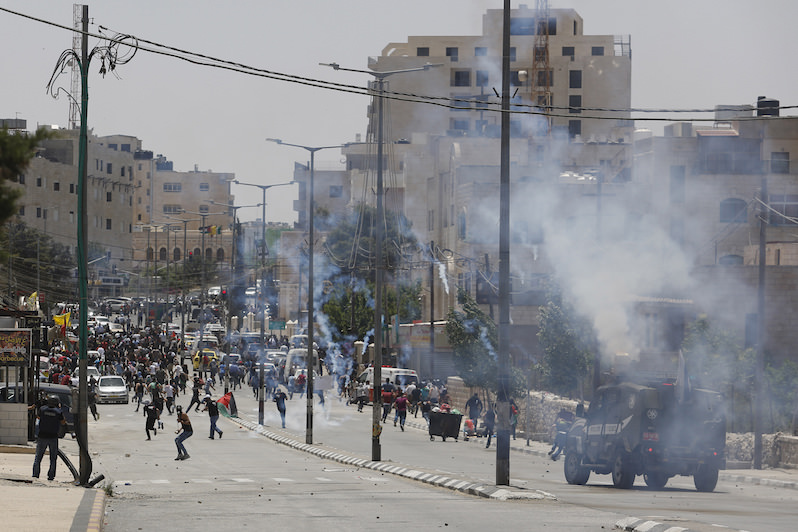50 Years After the Six-Day War: How to Make Peace in the Holy Land
Here is a direct, doable guide to help counteract today's dire realities and bring substantive change to the region. An Israeli security vehicle fires tear gas during clashes with Palestinians demonstrating in the West Bank city of Bethlehem in May. (Nasser Shiyoukhi / AP)
An Israeli security vehicle fires tear gas during clashes with Palestinians demonstrating in the West Bank city of Bethlehem in May. (Nasser Shiyoukhi / AP)
An Israeli security vehicle fires tear gas during clashes with Palestinians demonstrating in the West Bank city of Bethlehem in May. (Nasser Shiyoukhi / AP)
Fifty years ago, as the fog of the Six-Day War lifted and Israel celebrated its “miraculous” victory over Arab nations, a darker reality sank in. Israel’s military then dominated millions of Palestinians living on their own land. At the time, moral appeals within Israel and legal counsel in a secret Israeli Foreign Ministry memo warned of dire consequences if the occupation were not quickly abandoned.
Of course, the opposite happened. Year after year, thousands of Israelis, many who believed they were called by God, colonized the West Bank, threatening the dream of two populations living side by side in peace. The first Oslo Accord, signed in 1993 supposedly to facilitate a two-state solution, instead helped make one nearly impossible.
Consider:
● The Israeli West Bank settler population has nearly quadrupled to about 400,000 since Yitzhak Rabin and Yasser Arafat shook hands on the White house lawn after signing that Oslo Accord in September 1993. ● More than a dozen Jewish settlements now ring East Jerusalem, the would-be capital of an independent Palestinian state, virtually snuffing out the two-state dream. ● Sixty percent of the West Bank remains under Israel’s full military control, with hundreds of barriers forcing Palestinian families into increasingly isolated cantons. ● Israel essentially controls so-called Area A autonomous zones, with checkpoints at the entrances of most Palestinian towns, and frequent night raids take place, which the military implements with impunity. In one incident straight out of the Jim Crow South, soldiers took over a swimming pool in Area A, forcing Palestinians out of the water so settlers could take a dip.
Nearly all this has happened under Oslo’s derelict watch. The Oslo Declaration of Principles, which mentions security 12 times but never once independence, sovereignty, freedom or Palestine, was never designed to stop such expansion. Instead, it has facilitated it.
Fifty years after the end of the Six-Day War, the core problem remains Israel’s occupation, which has grown ever more oppressive since June 10, 1967.
So, what to do?
The “experts” who have overseen the Oslo disaster argue for reviving the peace process. But this would lead to at best a rump Palestinian statelet, while promising decades of future bloodshed.
The reality on the ground in Israel/Palestine is already that of a single state, with sharply diverging sets of civil and human rights, depending on your nationality and (lack of) citizenship. Never mind that leaders and pundits from former Israeli prime ministers Ehud Olmert and Ehud Barak to John Kerry and journalist Tom Friedman have warned of the coming apartheid if Israel doesn’t solve its moral crisis of colonial land acquisition. The deed already is done, the “A” word already applies, and the situation is getting worse by the day.
For those who agree that some form of just peace is preferable to the status quo, here is a blueprint toward a durable solution in Israel and Palestine.
● Freeze settlement construction. Not a temporary halt; not a slowdown that allows for “natural growth.” A complete halt, now. Until that happens, no genuine solution will ever emerge. ● If you’re the U.S., act like a superpower: Link U.S. military aid to an absolute end to settlement construction. Not since 1991 when U.S. Secretary of State James Baker threatened Israeli Prime Minister Yitzhak Shamir with suspension of American loan guarantees has an American leader been willing to back up tough talk to Israel. It’s long past time. Eventually, this tool can be applied to relocation of settler populations. ● End the occupation, and lift the siege of Gaza. The West Bank barrier regime is in place largely to protect settlers who don’t belong there. But massive confinement has created a human rights nightmare. U.S. and international pressure could help bring down hundreds of barriers and end the siege of Gaza. Both are examples of collective punishment that has fueled greater rage—a fury that does not bode well for the yet-unborn. ● Encourage, don’t vilify, nonviolent resistance. The demonization of the Boycott, Divestment, Sanctions movement is hypocritical and counterproductive. Consider the movement’s targeting of Caterpillar, the company whose D9 bulldozer has helped Israel demolish tens of thousands of Palestinian dwellings. How is highlighting Caterpillar’s behavior part of an effort “to malign and undermine Israel and the Jewish people,” as U.S. presidential candidate Hillary Clinton wrote in an anti-BDS letter to her patron, Israeli-American mogul Haim Saban?● Embrace a process of truth and reconciliation. This is not a step for tomorrow, or even next year. The Israeli historian, soldier and politician Meron Benvenisti once told me that this South African model of healing would never work because it is rooted in Christianity, and the vast majority in Israel/Palestine aren’t Christian. But Dalia Landau, the Israeli subject of my book “The Lemon Tree,” is right when she calls for Israelis and Palestinians to confront the past through “the three A’s”: acknowledgment, apologies and amends. This would be a slow and deliberate process of trust- and confidence-building. What exact reality it would lead to, we can’t yet know. ● Move beyond denial, and begin exploring genuine alternatives. Unless the U.S. insists that Israel moves a large portion of its 400,000 West Bank settlers—and the 200,000 surrounding Arab East Jerusalem—a two-state solution, with a viable, contiguous independent state of Palestine, will never happen. Although it may be hard to consider how bi-national or parallel states might work, it is far better than perpetuating the illusion that jump-starting peace talks will lead us anywhere new.
Think about the steps that would be possible if the U.S. began to implement a forceful, anti-colonial policy rooted in human and civil rights and equal treatment under the law. Then, allow yourself to dream of a reachable future.
With the physical barriers down—eventually, this would include the separation wall—Israelis and Palestinians could move freely across the Holy Land, visiting family, swimming in the Mediterranean and worshipping at sacred sites in Jerusalem, Bethlehem and Hebron without fear of attack.
Jerusalem would evolve into an open city, where culture, commerce, art and faith would produce a spectacular mosaic. Jerusalem could sparkle as an example of tolerance and multiethnic cosmopolitanism. A few miles south, millions would flock to Bethlehem, now a sad town surrounded by concrete and barbed wire, but in this vision, transformed into the newly accessible birthplace of Christ.
Once the boycotts and international condemnations vanished, culture and commerce would soar, with strong global backing. Musicians, artists and writers would bear witness to the fruits of a just peace. Economies and infrastructures would connect across the borders separating former enemies. A new Orient Express could chug from Haifa to Saudi Arabia. Israel could share its farm and water conservation technology with the entire Arab world; engineers across the region could work on joint solar power projects. Israelis could visit Lebanon and other Arab neighbors—only this time, the Israelis wouldn’t be in uniform. Arabs from the Gulf to the Levant could set foot in the Holy City and pray at Al Aqsa Mosque.
Significantly for U.S. policy, America would no longer be the central focus of rage on the Arab “street.” With true peace in the Holy Land, Islamic State and al-Qaida would have lost their greatest recruiting tool: the unmitigated tragedy of Palestine.
Call me a dreamer. But I prefer to envision the day when people in Israel and Palestine don’t have to instinctively look over their shoulders. Where Arab and Jew can one day look each other in the eye, as equals. Where 50 years of occupation can finally be transformed.
Your support matters…Independent journalism is under threat and overshadowed by heavily funded mainstream media.
You can help level the playing field. Become a member.
Your tax-deductible contribution keeps us digging beneath the headlines to give you thought-provoking, investigative reporting and analysis that unearths what's really happening- without compromise.
Give today to support our courageous, independent journalists.






You need to be a supporter to comment.
There are currently no responses to this article.
Be the first to respond.